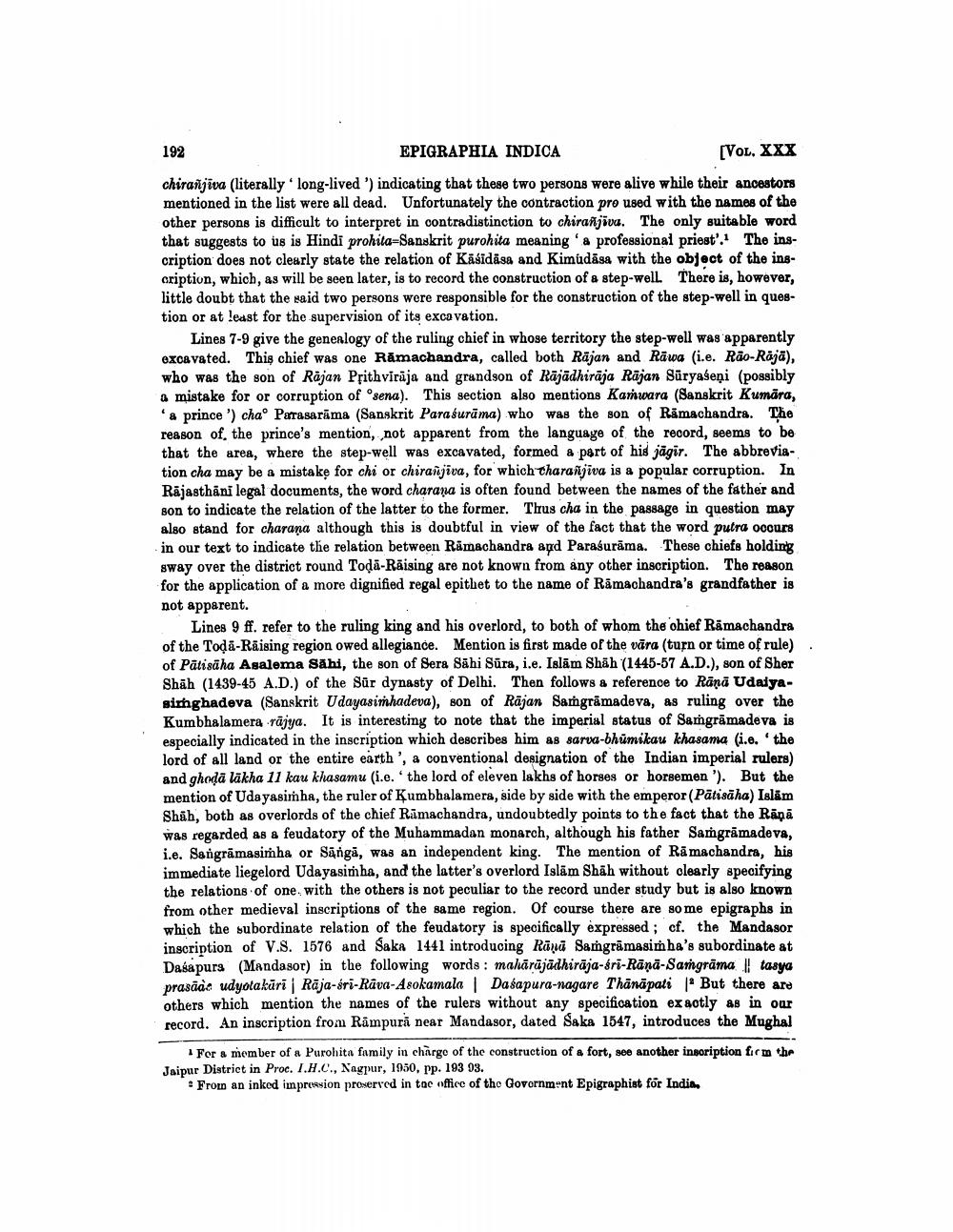________________
192
EPIGRAPHIA INDICA
[VOL. XXX
chiranjīva (literally long-lived') indicating that these two persons were alive while their ancestors mentioned in the list were all dead. Unfortunately the contraction pro used with the names of the other persons is difficult to interpret in contradistinction to chiranjāvu. The only suitable word that suggests to us is Hindi prohita-Sanskrit purohita meaning a professional priest'. The inscription does not clearly state the relation of Kāśidāsa and Kimudāsa with the object of the inscription, which, as will be seen later, is to record the construction of a step-well. There is, however, little doubt that the said two persons were responsible for the construction of the step-well in question or at least for the supervision of its excovation.
Lines 7-9 give the genealogy of the ruling chief in whose territory the step-well was apparently excavated. This chief was one Ramachandra, called both Räjan and Rāwa (i.e. Rāo-Räjā), who was the son of Rajan Prithviraja and grandson of Rājādhiraja Rajan Süryaseņi (possibly a mistake for or corruption of sena). This section also mentions Kanwara (Sanskrit Kumāra, '& prince') chao Parasarāma (Sanskrit Parasurāma) who was the son of Ramachandra. The reason of the prince's mention, not apparent from the language of the record, seems to be that the area, where the step-well was excavated, formed a part of his jāgir. The abbreviation cha may be a mistake for chi or chiranjiva, for which tharanjiva is a popular corruption. In Rajasthāni legal documents, the word charana is often found between the names of the father and son to indicate the relation of the latter to the former. Thus cha in the passage in question may also stand for charana although this is doubtful in view of the fact that the word putra occurs in our text to indicate the relation between Ramachandra and Parasurama. These chiefs holding sway over the district round Toda-Räising are not known from any other inscription. The reason for the application of a more dignified regal epithet to the name of Ramachandra's grandfather is not apparent.
Lines 9 ff. refer to the ruling king and his overlord, to both of whom the chief Ramachandra of the Toda-Raising region owed allegiance. Mention is first made of the vāra (turn or time of rule) of Patisäha Agalema Sähi, the son of Sera Sāhi Sūra, i.e. Islam Shah (1445-57 A.D.), son of Sher Shāh (1439-45 A.D.) of the Sur dynasty of Delhi. Then follows & reference to Rārā Udaiyasimghadeva (Sanskrit Udayasimhadeva), son of Rajan Samgrāmadeva, as ruling over the Kumbhalamera rājya. It is interesting to note that the imperial status of Samgrāmadeva is especially indicated in the inscription which describes him as sarva-bhumikau khasama (i.e. the lord of all land or the entire earth', a conventional designation of the Indian imperial rulers) and ghodā lākha 11 kau khasamu (i.e. the lord of eleven lakhs of horses or horsemen '). But the mention of Udayasimha, the ruler of Kumbhalamera, side by side with the emperor (Patisäha) Islam Shāh, both as overlords of the chief Ramachandra, undoubtedly points to the fact that the Rānā was regarded as a feudatory of the Muhammadan monarch, although his father Samgrāmadeva, i.e. Sangrāmasimha or Sänga, was an independent king. The mention of Rāmachandra, his immediate liegelord Udayasimha, and the latter's overlord Islām Shah without clearly specifying the relations of one, with the others is not peculiar to the record under study but is also known from other medieval inscriptions of the same region. Of course there are some epigraphs in which the subordinate relation of the feudatory is specifically expressed ; cf. the Mandagor inscription of V.S. 1576 and Saka 1441 introducing Rana Samgrāmasimha's subordinate at Dasapurs (Mandasor) in the following words: mahārājādhiraja-sri-Rāņā-Sangrāma! tasya prasāde udyotakāri Raja-sri-Rava-Asokamala Dasapura-nagare Thanapati | But there are others which mention the names of the rulers without any specification exactly as in our record. An inscription from Rāmpurā near Mandasor, dated Saka 1547, introduces the Mughal
For a member of a Purohita family in charge of the construction of a fort, see another inscription form the Jaipur District in Proc. I.H.C., Nagpur, 1930, pp. 193 93.
: From an inked impression proserved in tac office of the Government Epigraphist for India




